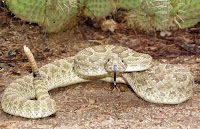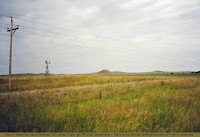History and Old Stuff...
The following rattlesnake stories are quoted from the book, Mellette County, 1911-1961*. Mellette County lies just north of the Rosebud Indian Reservation in south central South Dakota.
The book tells the stories of pioneers who settled Mellette County, South Dakota, after the state of South Dakota reneged on an 1868 peace treaty that had given the land to the Sioux Indians. The land was thrown open for settlement in 1911, and thousands of people came to enter their names in a drawing to have the privilege to buy the prairie land.
Some common themes run through many of the pioneer stories--the blizzards, the grasshoppers and "Mormon crickets," the fenceless range, the repeated and dangerous well-digging until water was finally found, the diphtheria and influenza--and the rattlesnakes!
During the century since settlement began in Mellette County, prairie dogs (one of the rattlesnakes' main foods) have been reduced to a tiny fraction of their 1911 population. I doubt that the rattlesnakes thrive as they once did on the prairie lands, though I am sure they may still be found.
From the story of Jens J. Norup:
...Rattlesnakes were more than plentiful when we were all breaking sod with walking plows. It seems like I killed a snake nearly every day during the hot summer weather for three years or more. Three young homesteaders in less than three hours killed over 100 snakes in one day...
From the story of Otto Hansen:
...The first year, I borrowed a team from Dan Ryan, a neighbor, to go with a team I'd bought which were not broke to work. One day while breaking sod with them, I heard a rattler buzzing under my feet. The plow share had just skinned his back and pulled him out of his hold. Did I ever get out of that furrow! And I would not get back in the rest of that day. I wore boots after that. I broke 25 acres that year with a walking plow...
From the story of Mrs. Maymie Hutchens:
...Rattlesnakes were plentiful on the prairies and the homesteaders had to be very careful for they would crawl under their shacks and when you walked across the floor they would hiss and rattle...
From the story of Beulah Krieger Towne:
...When Dad had selected our ranch he had picked the most beautiful spot in the whole country, nestled at the north edge of a range of buttes. There were no buildings, so we slept in a tent the first night. The carpenters and hired men bedded down on blankets under the stars, inside a circle of lariat rope to keep the rattlesnakes away...
J. B. Brown and his bride of a few days arrived in October of 1912. They had a long, hard first winter, but they planted a big garden as soon as the snow drifts were gone and the weather had warmed during their first spring. From his story:
...Mrs Brown, armed with a long handled hoe, not only helped to keep the weeds down, but she also killed some 10 or 12 large rattlesnakes that crossed her path between the house and the garden...
From the story of Fay Kaufman:
...I went to see my mother one day. The dog was really up in the air about something. We both went out and there were two very large snakes. Mother sent me to the house for a gun. Of course, I had to pick up an automatic revolver which neither one of us knew how to shoot. A good thing we didn't get the gun off safety for it would have shot a full round before stopping. The rattlesnakes turned out to be the biggest bull snakes [a non-poisonous prairie snake] I have ever seen. Mother and I had many a laugh years later.
From the story of Mrs. Mae Strange Snyder:
Rattlesnakes were one of the hazards of those times. One day I rode down to see Mrs. George Kent. A rattler crawled across the road. I took the bridle off my horse and tried to kill it. About that time, Floyd Eaton happened by. He ended up killing 17 and said that some had crawled into their holes. It happened to be a den of them.
I am not sure which species or subspecies of rattlesnakes they had in Mellette County, South Dakota, but I suspect the rattlers they encountered were prairie rattlesnakes.
I took the photo below on the Rosebud Indian Reservation, about five miles south of the Mellette County line, along Highway 18 east of Mission, South Dakota.

* Source of the above quotes: Mellette County, 1911-1961, published by the Mellete County Centennial Committee of White River, South Dakota. No copyright information or publication date is given.
Technorati tags:


No comments:
Post a Comment